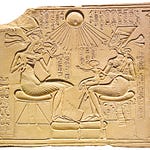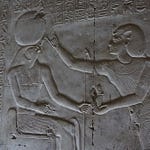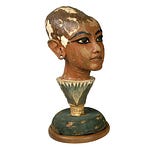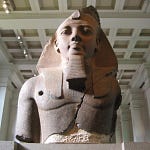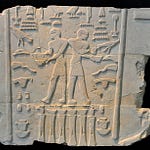Who should inherit the throne when the ancient Egyptian king is killed? The strong brother of the king or the younger son who needs serious time to mature? This was a vital question that the Egyptians solved through mythology.
Egypt found itself in a power vacuum; it was the first political crisis the land had ever experienced. The primary god-king was dead, killed by his own brother. Who should become king next? Should Seth, the murderer of Osiris, inherit the throne of Egypt over Osiris’ son, Horus? It was ann age-old question of succession, property, violence, power, and, yes, legal suits. If you think Americans love litigation, well the ancient Egyptians can beat that. This myth about the contendings between Horus and Seth is essentially a big legal proceeding in front of a tribunal of divinities, some emotionally stable, some not so much. It’s a rip-roaring time of litigation and counter-suits!
Join us in the podcast episode as Kara and Amber continue their discussion of Seth, god of chaos and violence, by diving into a text known as “The Judgement of Horus and Seth,” that vital mythological account about the interminable conflict—stone boat races! Spear fishing! Rape, but only kind of!—between Horus and Seth over who is the rightful heir to Osiris. It is the story about how the young and rightful heir Horus triumphs over the violent intercession, and it offers insights into ancient Egyptians perceptions of kingship and its troubled relationship to masculinity and violence. Kara and Amber wrap the podcast up with a look at how Seth fell from favor in Egypt’s Late Period and was ultimately demonized as a force for evil.
Get ready for the most bawdy tale from Pharaonic Egypt…
Sources
Cruz-Uribe, Eugene. 2009. Stx aA pHty “Seth, god of power and might.” Journal of the American Research Center in Egypt 45, 201-226.
Lichtheim, Miriam 2006. Ancient Egyptian literature. A book of readings, volume II: The New Kingdom. Berkeley, CA; London: University of California Press.
Morris, E. F. 2007. Sacred and obscene laughter in The Contendings of Horus and Seth, in Egyptian inversions of everyday life, and in the context of cultic competition. In Schneider, Thomas and Kasia Szpakowska (eds), Egyptian stories: a British Egyptological tribute to Alan B. Lloyd on the occasion of his retirement, 197-224. Münster: Ugarit-Verlag.
Schott, Siegfried 1929-1939. Urkunden mythologischen Inhalts [VI, 1-144], 2 vols. Urkunden des Ägyptischen Altertums VI (1-2). Leipzig: Hinrichs.
te Velde, H. 1967. Seth, god of confusion: a study of his role in Egyptian mythology and religion. Translated by G. E. van Baaren-Pape. Probleme der Ägyptologie 6. Leiden: E. J. Brill.







